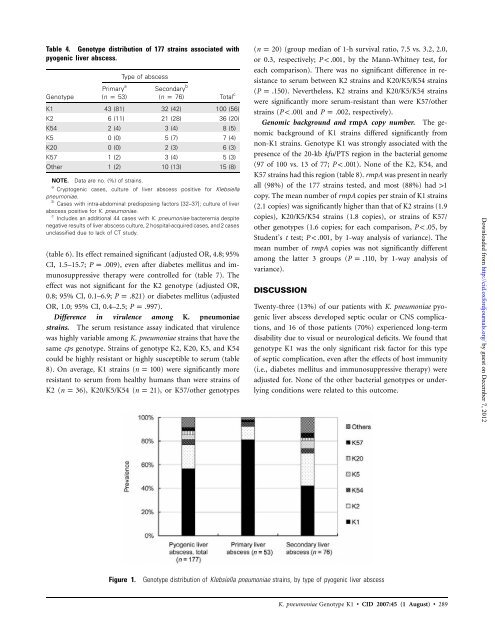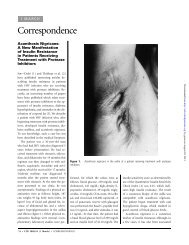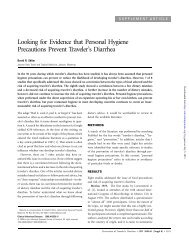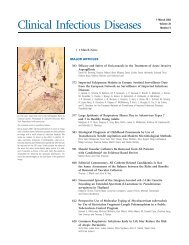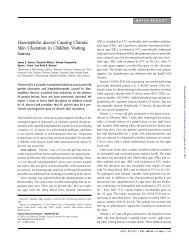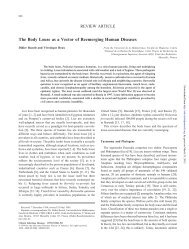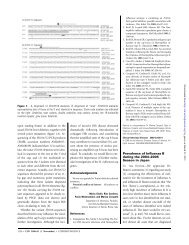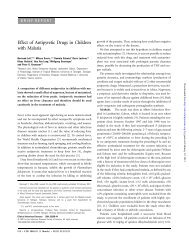Klebsiella pneumoniae - Clinical Infectious Diseases
Klebsiella pneumoniae - Clinical Infectious Diseases
Klebsiella pneumoniae - Clinical Infectious Diseases
You also want an ePaper? Increase the reach of your titles
YUMPU automatically turns print PDFs into web optimized ePapers that Google loves.
Table 4. Genotype distribution of 177 strains associated with<br />
pyogenic liver abscess.<br />
Genotype<br />
Primary a<br />
(n p 53)<br />
Type of abscess<br />
Secondary b<br />
(n p 76)<br />
Total c<br />
K1 43 (81) 32 (42) 100 (56)<br />
K2 6 (11) 21 (28) 36 (20)<br />
K54 2 (4) 3 (4) 8 (5)<br />
K5 0 (0) 5 (7) 7 (4)<br />
K20 0 (0) 2 (3) 6 (3)<br />
K57 1 (2) 3 (4) 5 (3)<br />
Other 1 (2) 10 (13) 15 (8)<br />
NOTE. Data are no. (%) of strains.<br />
a<br />
Cryptogenic cases, culture of liver abscess positive for <strong>Klebsiella</strong><br />
<strong>pneumoniae</strong>.<br />
b<br />
Cases with intra-abdominal predisposing factors [32–37]; culture of liver<br />
abscess positive for K. <strong>pneumoniae</strong>.<br />
c<br />
Includes an additional 44 cases with K. <strong>pneumoniae</strong> bacteremia despite<br />
negative results of liver abscess culture, 2 hospital-acquired cases, and 2 cases<br />
unclassified due to lack of CT study.<br />
(table 6). Its effect remained significant (adjusted OR, 4.8; 95%<br />
CI, 1.5–15.7; P p .009),<br />
even after diabetes mellitus and immunosuppressive<br />
therapy were controlled for (table 7). The<br />
effect was not significant for the K2 genotype (adjusted OR,<br />
0.8; 95% CI, 0.1–6.9; P p .821)<br />
or diabetes mellitus (adjusted<br />
OR, 1.0; 95% CI, 0.4–2.5; P p .997).<br />
Difference in virulence among K. <strong>pneumoniae</strong><br />
strains. The serum resistance assay indicated that virulence<br />
was highly variable among K. <strong>pneumoniae</strong> strains that have the<br />
same cps genotype. Strains of genotype K2, K20, K5, and K54<br />
could be highly resistant or highly susceptible to serum (table<br />
8). On average, K1 strains ( n p 100)<br />
were significantly more<br />
resistant to serum from healthy humans than were strains of<br />
K2 ( n p 36), K20/K5/K54 ( n p 21),<br />
or K57/other genotypes<br />
( n p 20)<br />
(group median of 1-h survival ratio, 7.5 vs. 3.2, 2.0,<br />
or 0.3, respectively; P ! .001,<br />
by the Mann-Whitney test, for<br />
each comparison). There was no significant difference in resistance<br />
to serum between K2 strains and K20/K5/K54 strains<br />
( P p .150).<br />
Nevertheless, K2 strains and K20/K5/K54 strains<br />
were significantly more serum-resistant than were K57/other<br />
strains ( P ! .001 and P p .002,<br />
respectively).<br />
Genomic background and rmpA copy number. The genomic<br />
background of K1 strains differed significantly from<br />
non-K1 strains. Genotype K1 was strongly associated with the<br />
presence of the 20-kb kfu/PTS region in the bacterial genome<br />
(97 of 100 vs. 13 of 77; P ! .001).<br />
None of the K2, K54, and<br />
K57 strains had this region (table 8). rmpA was present in nearly<br />
all (98%) of the 177 strains tested, and most (88%) had 11<br />
copy. The mean number of rmpA copies per strain of K1 strains<br />
(2.1 copies) was significantly higher than that of K2 strains (1.9<br />
copies), K20/K5/K54 strains (1.8 copies), or strains of K57/<br />
other genotypes (1.6 copies; for each comparison, P ! .05,<br />
by<br />
Student’s t test; P ! .001,<br />
by 1-way analysis of variance). The<br />
mean number of rmpA copies was not significantly different<br />
among the latter 3 groups ( P p .110,<br />
by 1-way analysis of<br />
variance).<br />
DISCUSSION<br />
Twenty-three (13%) of our patients with K. <strong>pneumoniae</strong> pyogenic<br />
liver abscess developed septic ocular or CNS complications,<br />
and 16 of those patients (70%) experienced long-term<br />
disability due to visual or neurological deficits. We found that<br />
genotype K1 was the only significant risk factor for this type<br />
of septic complication, even after the effects of host immunity<br />
(i.e., diabetes mellitus and immunosuppressive therapy) were<br />
adjusted for. None of the other bacterial genotypes or underlying<br />
conditions were related to this outcome.<br />
Figure 1. Genotype distribution of <strong>Klebsiella</strong> <strong>pneumoniae</strong> strains, by type of pyogenic liver abscess<br />
K. <strong>pneumoniae</strong> Genotype K1 • CID 2007:45 (1 August) • 289<br />
Downloaded from<br />
http://cid.oxfordjournals.org/ by guest on December 7, 2012


